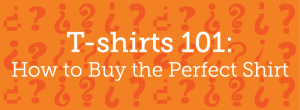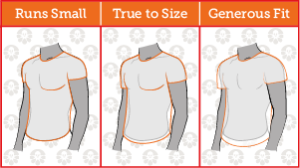T-shirts 101: How to Buy the Perfect T-shirt
Welcome to T-Shirts 101!
When it comes to our t-shirt selection, the sky’s the limit. But with so many options to pick from, how can you find something your whole group will love? Don’t worry — we know outfitting an entire group can be tough, so we’ve written this handy guide to help you on your path to the perfect shirt. Whether you’re visiting Custom Ink for the first time, looking for the scoop on the hottest styles, or just want to learn more about t-shirts, we’ll cover everything you need to know before you start.
Sleeve Lengths: Choosing by Activity
“Two sleeves, or not two sleeves? That is the question.” – William Inkspeare.
One of the first decisions you’ll need to make when shopping for shirts is sleeve length. To many, sleeves are a practical consideration. A long sleeve t-shirt might provide extra warmth in cold weather, for example, but would be far less comfortable in the dog days of summer. Consider when, where, and why you’ll be wearing your shirt to determine which length best suits your needs:
Short Sleeves: A closet staple – the t-shirt is a garment known by its shape, with sleeves that extend midway down the arm. Great for any occasion.
Long Sleeves: Sleeves extend from the shoulder all the way down to the wrist. Better for cold weather climates and winter gatherings.
Tank Tops & Sleeveless: Shirts without sleeves sewn onto the body. Great for warm weather, athletics, and showing off those arm muscles.
Styles to Look For
“Pockets and raglans and ringers, oh my!”
After you’ve decided on sleeve length, it’s time to start thinking about style. Whether you’re looking for fashion, function, or somewhere in between, we’ve got something for everyone. Here are a few of our most popular shirt style options:
Ladies & Juniors: These styles are tailored to contour to a feminine silhouette, with a narrower bust, tapered torso and shorter sleeves for a flattering look. Juniors garments are usually more form-fitted than Ladies, so consider sizing up.
Performance: These high-tech, sporty styles are made from lightweight materials that keep you feeling cool and dry during athletic activities.
Pocket T’s: A popular feature on t-shirts for more than a century, pockets are positioned in the upper left chest area. Great for storage!
Raglans: Raglans feature sleeve fabric that extends from the collar all the way down the arm, offering comfort and range of motion. The sleeve is a different color than the body of the shirt for a “baseball jersey” look.
Ringers: These two-tone, trendy styles feature fabric ribbing around the neck collar and sleeve bands in a color different from the color used on the body of the shirt.
Necklines: Styles can also be differentiated by the shape of the neck opening.
- Crewneck: The round, circular neck opening most commonly seen on t-shirts.
- V-neck: A V-shaped neck opening that is often cut deeper than a crewneck, exposing more of the upper chest.
- Scoop neck: A curved neck opening that extends wider and deeper into the chest than a crewneck.
Fabric & Materials
It’s been true since the 80s—we live in a material world. But do you know what fabric materials are used to make t-shirts? Fabric can affect the way a shirt looks, feels, and functions, so here’s what you need to know about the most common shirt fabrics:
Cotton: A fluffy, natural fiber obtained from cotton plants that is commonly used to make fabric materials. The methods in which cotton is grown, harvested, spun into thread, and woven affect its thickness and feel.
100% Cotton: These styles are made from fabric containing only cotton materials.
Polyester: A synthetic (man-made) fiber often used for shirts. Light, durable, and flexible, polyester shrinks less than cotton and can provide practical benefits such as moisture wicking.
Blends: Any material that is made up of more than one type of fiber, offering a mix of softness and durability.
50/50 Blends: Equal parts of cotton and polyester are blended to produce a durable, breathable material.
60/40 Blends: Blending 60% cotton and 40% polyester together for an extremely soft feel.
Tri-Blends: 50% cotton, 25% polyester, and 25% rayon are blended together to create this luxurious silky smooth fabric.
Know Your Fit
“If the shirt fits, it’s probably your size.”
Remember, it’s not just about looking good, it’s about feeling good too! The fit of a shirt should flatter your body shape and feel the way you want it to. Since production techniques vary among manufacturers, brands and styles can offer different fits even if they’re the same size! To help narrow it down, we describe which type of fit you should expect from a shirt above the Sizing Line-Up(SM) on every product page.
Runs small: A slim-cut, ‘modern’ fit that typically speaks to a younger audience.
True to size: A regular, ‘average’ cut that generally fits true to standard industry size measurements.
Generous fit: A roomy, ‘loose’ fit for select unisex styles. These allow for a liberal amount of room in a person’s standard size.
We’re Here to Help
Although there are a lot of decisions to make when shopping for shirts, we hope you’ve learned enough to start your journey through our product catalog. Remember, Inkers are here to help, so give us a call at 800-293-4232 or email us with any questions or concerns. We love to talk shirts!
FAQs
What is Preshrinking? Preshrinking is a process in which fabric is run through rollers that press grooves into the material, condensing it before it is cut and sewn into a garment. These grooves loosen gradually after repeated washes, allowing residual shrinkage to naturally occur over a period of time.
How much should my 100% cotton t-shirt shrink in the wash? Especially when laundered in high heat, cotton has the potential to shrink, and you want your shirt to fit your body after washing. Preshrunk 100% cotton fabrics can shrink up to 4-5% at the time of the first washing. Make sure your 100% cotton t-shirt’s fabric is pre-shrunk before you buy it, or order a size up and allow for some shrinkage if your t-shirt is not pre-shrunk.
What’s an organic t-shirt? T-shirts listed as ‘organic’ are made of 100% cotton material grown in sustainable eco-friendly conditions, with no harmful synthetic dyes or chemicals added during production. To qualify as organic, production processes must meet the standards for organically-produced agricultural products set forth by the USDA National Organic Program.
How much does a Gildan Ultra Cotton T-shirt weigh? The weight says 6.1 oz. but there’s no shirt size listed. Contrary to popular belief, the ounce weights listed on every product page indicate the weight of a square yard of a shirt’s fabric material — the shirts themselves aren’t weighed. We include this information because most t-shirts and polos can be categorized as lightweight, midweight or heavyweight, depending on the weight of the fabric.
Lightweight: Anything under 5.0 oz.
Midweight: Between 5.0 and 6.0 oz.
Heavyweight: Anything over 6.0 oz.
So, our newfound knowledge of Fabric Weight Ranges tells us that all Gildan Ultra Cotton T-shirts are ‘heavyweight’ regardless of shirt size since the fabric weighs over 6 ounces.




Leave a Comment